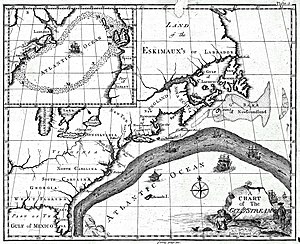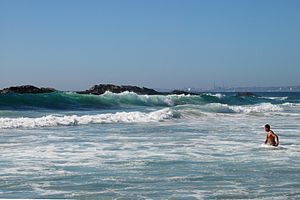Amongst the omissions or subjects I have yet to tackle, one of the more obvious has been relatively little coverage of environmental issues.
A little knowledge is a dangerous thing, they say. I’ve tackled many open water swimming subjects here, sometimes because I didn’t know enough to be daunted, or because I thought that while my knowledge may be limited, it was more important to partially cover something, rather than leave it undone.
The environmental challenges and threats to the ocean environment, as you should know even if you deny them, are profound, complex and far-reaching, and generally seemingly intractable. From ocean warming and acidification to biodiversity loss, pollution, habitat destruction, climate change and more. Each aspect has been worthy of huge amounts of research and work, discussion and debate. We still have even more to learn and understand. Yet for someone who writes about swimming in the natural world, there is little direct reference to many of these challenges and threats.
I love the sea. More specifically I love the Atlantic, my ocean. I have what Tolkien called the “sea-longing“. I don’t love the sea the way people love a golf course or a football team. I love it more the way a sailor loves it, the way a fisherman loves it. It’s part of who I am, and what I am. It is, for want of a better comparison, some kind of almost spiritual thing. Despite their apparent klunkyness, I choose such loose words carefully, “kind of an almost thing“, because I don’t really want to name it or compare it to something constructed by others which will give you some notion extracted from those labels. My feelings about the sea, whatever it is that opens up inside me when I am beside, on or in it, isn’t actually spiritual or religious. It’s just difficult to name or to explain. It’s not that the words don’t exist, it’s that I’m not trying to find them, not trying to circumscribe those feelings. They may be laughable to everyone else, and I’m perfectly fine with that.
![Tramore Bay_MG_8972.resized]()
I was surfing one day, well over a decade ago in Tramore at the Bay’s main surf spot, a series of breaking lefts and rights, right in front of the beach. It was May, one of the best surfing months with warming summer weather and very long northern latitude evenings. Swells from the tail-end of winter storms roll across the Atlantic, one waves catches another and doubles in size, two others destructively cancel each out, and over the course of one or two thousand miles, the period between waves grows as does the amplitude, and the surfer’s desire of groundswell develops. If the winds co-operate, if some other weather pattern doesn’t interfere, the ideal result is a series of regular, powerful waves hitting a coast. If the sea and weather collide, there will be a slight offshore breeze to groom the waves to shape, and if the sea and weather gods are particularly favourable, the air will be still. If the air is still the water will glass-off. The surface will be like an oil-slick. Lack of wind is rare on Irish coasts.
I lay on my board, waiting and hoping that the small regular waves were the precursor of a larger swell to soon arrive. And as I lay there I saw a mass in the water really close. Maybe a couple of metres around. And brown. It was obvious what it was. Speaking with one of the Tramore surfers, I was informed that there was a sewage outlet behind the beach, which was irregularly dumped into the sea when the tank was full.
I wrote some letters to media, print and broadcast, the only outlets my Mr Angry of Tonbridge Wells, and many others have in the short-term for expressing shock, outrage and generally ineffectual anger at the bewildering world around us. In my angsty missives, I focused on the pressure points of commerce. How could a town which relied on tourism and sea deliberately and wilfully pollute that very resource? And to do it in such a way that it directly risked the health of people and therefore the reputation and commercial viability of the local economy?
There were denial and contradictory responses from officialdom. “No, we don’t do that“. “No, we only do it on high tide“. “No, it goes far out into the bay“. “No, we already started a new treatment plant“. My favourite was “he’s lying, the water is still too cold for swimming and he would have died“, someone who’d never heard of those new-fangled wetsuit things. Individuals supported me, local commerce was silent and local politicians lied and denied it all, even the one who’d been elected on that specific issue.
One personal effect was to understand first-hand just how vested interests at the most local level will close ranks in a short-sighted bulwark to stand against perceived threat from outside, yet delude themselves as to their own complicity in the cause. A microcosm of global environmental issues. It took some years, the loss I’d predicted in that original letter of Tramore’s prized Blue Flag status, (originally an EU scheme which designates good quality bathing locations, taking a range of factors into account, to improve water quality and other indicators) and much more prevarication and local protectionism and nimbyism before the new Tramore sewage treatment scheme was built and bay finally cleaned up. Inspired by the events during that time I completed a post-graduate environmental science degree, though I’ve never subsequently worked in the area, nor been directly involved in any environmental campaigns outside some of the day-to-day changes I made in my own life, some years before some of those became mandatory.
One of, if not the biggest challenge of anyone working, studying or simply interested in environmental issues, is realising the scale of the multitudinous threats. Each such person stands before a world in crisis, and in ourselves we feel overwhelmed. How can one or even some of us stand against centuries of depredation of the natural world, the effects of which grows year on year, threat on threat, consequence on consequence? How can we make a difference, especially since most of us aren’t those special people who can change the world?Despair and depression are a natural human responses to the realisation of the magnitude of the environmental crisis, and the other is denial. Maybe if we were united as a species, or even as countries to respond we could slow the effects. But we aren’t united. The Tramore town council and Chamber of Commerce scale up. The lies and misdirection occur on transnational and global scales. Environmentalist becomes a caustic insult as well as a badge of revolt. On the one side you have eco-warriors in dreadlocks, on the other populist politicians and industrialists in starched shirts. Divisive, and antagonistic, short-sighted and self-serving.
What do average people like us do? Give up, ignore the problem, leave it to the future. Or you can, as so many others have, fall back onto the environmental adage, that seems clichéd and trite: Think globally, act locally. If there is a maxim for environmental action, that simple precept has alleviated the despair of many.
Environmental action needs big thinkers and big doers and it also supporters of each. For those ordinary rest of us, when we realise the threats, we can hide from them, and push the problem, as most have done, into the future, or we somehow take action. Environmentalists, (even the term is exclusionary at best) like the supposed American First Nation adage that the world belongs to the seventh generation of our descendants, and we are merely caretakers.
I’m not asking you to do anything big. I explained my own journey above because I wanted to put some context. To put some personal feeling and emotion into a discussion. To make it individual. Because I do want you to do something. Maybe more than one thing. But like I said above, I’m not asking you to do anything big. I want you to take a few simple personal actions, and then you decide from there.
Self-righteousness isn’t a solution. We do what we can, and try to improve. None of us are perfect and if we try to improve incrementally then we are making progress. A few plastic cups overboard? Not good, but not deliberate, and far less damaging that the insane traffic levels of Texas or California, and the larger repercussions thereof.
Try to improve, try to connect, try to protect.
What do I want you to do?
- I want you to swim in the sea.
Yes, really. The odds are that if you read this you do at some time anyway. But I want you to think about it as you do it, to try to feel that connection I always have when I am there. I want you I suppose, to swim in a “mindful” way. To feel just how being in the sea, preferably without a wetsuit, makes you feel so much more part of the world around you. Just for one day, forget about speed or distance or stroke or plans or ego (especially ego) or even dreams. Just try to feel part of the sea. Swim with your eyes open, swim with your eyes closed. Feel the movement that’s utterly unlike a pool. Look at the way the light diffracts, thinks about the microscopic flora and fauna that surround you that are the base of the chain of all life on earth. Because if you do it, really really do it, and feel the way I do, then you too will feel the sea-longing, the sea love and you will want to protect the ocean, to see it protected. If you don’t live near the ocean? Swim in a lake. Try to replicate it. And the next time you are near the ocean, try it. Please. Because the ocean is our mother, and many of us need to remember that.
- Take simple protective actions.
Make those local changes I mentioned. Which ones? Here are a couple of easy to implement suggestions:
Finally, don’t turn away. By which I mean, don’t ignore the problems. We don’t have to be environmental experts to realise that those who deny the problems do so out of self-interest, even if the self-interest is often no more than not wanting to feel any personal responsibility or guilt, rather than anything more sinister. Swim in the sea, learn to love it, and then take the steps that arise from that love, steps either small or large.
![]()
![]()

































































